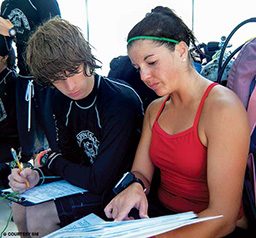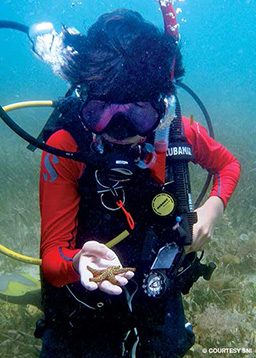For today’s average teenager, weekends and after-school hours are a whirlwind of activity with homework, athletics, SAT prep, community service, driving lessons, socializing — the list could stretch longer than fourth-period history class on a sunny spring day.
Some kids are multisport athletes. Some join clubs or dedicate hours to community service. Then there are the SCUBAnauts — a group of ultradedicated Florida students who somehow find time amid the chaos of teenage life to become top-notch scuba divers with scientific training rivaling that of the most-seasoned graduate students.
“These tend to be very high-achieving kids; they do well in school, sports and dance, but they also have a passion for marine science,” said Jim Cassick, executive director of SCUBAnauts International, the all-volunteer organization that operates three chapters in the Tampa Bay area and one in Key West.
SCUBAnauts isn’t just a résumé-builder though.
Since the group’s founding in 2001, the SCUBAnauts have traveled far and wide to participate in real underwater research projects, ranging from coral reef restoration in the Florida Keys to turtle and fish studies in Belize, with the goal of providing members with hands-on marine-science education and a close-knit community of positive role models.
A Unique Challenge

Like many of the organization’s leaders, Cassick first got involved with SCUBAnauts International in 2008 as a way to bond with his son, Colin, then a 12-year-old with a burgeoning interest in marine science. The program accepts students ages 12-18 and requires at least one adult per student to be actively involved in some way, whether by leading dive trips or organizing fundraisers.
By any measure, SCUBAnauts is intense. “When families join, we sit down and have a talk with them about what the program is and what it isn’t,” Cassick said. “It can take a lot to wrap your head around everything that’s involved.”
For starters, it requires participants to go through some of the most demanding dive and first-aid training in the industry. SCUBAnauts are expected to complete several higher-level courses in their first year, including advanced scuba diver certification, a Scuba Lifesaving and Accident Management (SLAM) rescue course and DAN’s Emergency Oxygen for Scuba Diving Injuries training. Each SCUBAnaut works toward American Academy of Underwater Sciences (AAUS) scientific diver qualification, which requires SCUBAnauts to meet a demanding set of standards followed by many universities, aquariums and government agencies.
Safety First, Then Science
Over the course of six years in the program, some SCUBAnauts will undergo more than 100 hours of safety instruction and another 180 hours of science education. “Sometimes it seems like our members spend more time in the classroom than in the water,” said Jim Alaniz, father of two SCUBAnauts and president of the organization’s Tarpon Springs chapter.

There’s a good reason for that. With the program’s overriding focus on marine science, SCUBAnauts need to be extra comfortable with the basics of diving before trying to transplant corals or survey reef fish. “Having their fundamentals down is so important because they’re multitasking,” Alaniz said. “You can see the difference when they hit the water and all that training kicks in.”
Elizabeth Moses, chief scientist for SCUBAnauts International, said that training is especially evident in their project with Mote Marine Laboratory to repair damaged reefs with nursery-grown corals in the Florida Keys National Marine Sanctuary. Working with very little instruction, the SCUBAnauts have been transplanting record numbers of the delicate corals and helping monitor the progress of the reef restoration.
Moses explained that a major part of the students’ scientific education involves teaching them to think critically and develop their own hypotheses they can test in the field. “We want the kids to parallel the way that scientists work,” she said, “to learn the scientific process and start coming up with their own questions.”
A Lasting Impact
The end result of all those hours upon hours of study, testing and experience in the field is a group of divers — some of them not even old enough to drive a car — who are calmer and more capable than most divers three times their age. “They’re twice as good as I am — I’m not even kidding!” Jim Alaniz said of his two children, Sofia and Danny, ages 17 and 19, respectively.
When Danny joined SCUBAnauts at age 12, Alaniz, then a nondiver, saw it as an opportunity to strengthen their relationship. “Diving, and in particular SCUBAnauts, allowed our family to stay close to each other over the years,” he said. “We have so many stories to tell.”
Sofia Alaniz, who is entering her final year of SCUBAnauts, said the experience has been “completely worth it,” despite the heavy time commitment. “I feel different from other students,” she said. “Being a part of it has let me grow and become a more well-rounded person than some of my friends.”
It also left her with a greater appreciation for the underwater world and a drive to pursue a career in marine science. “I’ve always had a fascination with the ocean, but I feel like SCUBAnauts has expanded my knowledge,” she said, “and it has become even more of a passion for me to follow.”
Perhaps surprisingly, the majority of SCUBAnauts graduates don’t follow a similar path, but Cassick said that’s not important. “Most of them don’t become marine scientists, and we’re OK with that — that’s not the goal,” he said. “No matter what they do, we hope they can take what they’ve learned and help the environment.”
© Alert Diver — Q3 Summer 2014